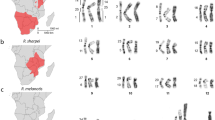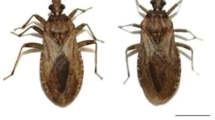Abstract
An analysis of the relative viabilities of recombinant and nonrecombinant chromosomes among the surviving embryos from back-crosses involving the Moreton (M) and Torresian (T) taxa has revealed that these embryos do not contain a representative sample of gametes derived from the F1 hybrid parent. The significant deviations in the hybrid gametic population arise entirely from intrachromosomal effects with no evidence of any between-chromosome interactions. This is interpreted as clear evidence to show that recombinational repatterning within heterozygous bivalents in the F1 parent is a significant factor in inducing the observed deviant segregation ratios. Furthermore, by using a population which is chromosomally equivalent to the Torresian but genically similar to the Moreton, it has been shown that over 46% of the F2 embryonic breakdown arises solely from the effects of chromosomal heterozygosity upon recombination repatterning among (Moreton × Torresian) F1 hybrids. From these data it is proposed that each chromosome is internally coadapted in the sense that it contains balanced blocks of cis-acting acting loci which can be disrupted by recombinational change. Disruption of the linear association of the genes on structurally different chromosomes by recombination repatterning results in novel intrachromosomal associations which may be functionally inadequate and so lead to arrested embryonic development. It is speculated that an important factor in arresting development may involve interactions between the novel recombinant chromosomes of the gamete and maternal factors laid down in the egg during oogenesis which are responsible for the sequential activation of the genomes of the progeny during development. Thus coadaptation is interpreted in terms of the functional intergration of a chromosome with the products of the genome of the previous generation. The assessment of the relative viabilities of recombinant and nonrecombinant chromosomes has shown that the Torresian nonrecombinant chromosomes possess the highest viabilities in the sequence TN>MN≧TR = MR where N and R represent nonrecombinant and recombinant classes. This sequence is relevant to the structure of the hybrid zone between the Torresian and Moreton taxa and explains both its asymmetry and the basis of the observed introgression of Torresian chromosomes into the Moreton taxon and the absence of the reverse movement.
Similar content being viewed by others
References
Allard, R.W., Babbel, G.R., Clegg, M.T., Kahler, A.L.: Evidence for coadaptation in Avena barbata. Proc Natl. Acad. Sci. (Wash.) 69, 3043–3048 (1972)
Avise, J.C.: Genetic differentiation during speciation. In: Molecular Evolution (F.J. Ayala, ed). Sinauer. Mass. (1976)
Ayala, F.J.: Genetic differentiation during the speciation process. Evol. Biol. 8, 1–78 (1967)
Bahn, E.: Cytogenetical localisation of the amylase region in Drosophila melanogaster by means of translocations. Hereditas (Lond.) 67, 75–78 (1971)
Baker, W.K.: Mechanisms of chromosomal and gene inactivation in Drosophila. Genetics 78, 333–341 (1974)
Barton, N.H.: The width of the hybrid zone in Caledia captiva. Heredity 47, 279–282 (1981)
Bickham, J.W., Baker, RJ.: Canalisation model of chromosomal evolution. In: Models and methodologies in evolutionary theory (J.H. Schwartz and H.G. Rollins eds.). Bull Carnegie Mus. Natl. Hist. 13, 70–84 (1979)
Brown, A.H.D.: Isozymes, plant population genetic structure and genetic conservation. Theor. Appl. Genet. 52, 145–157 (1978)
Carson, H.L.: The genetics of speciation at the diploid level. Am. Nat. 109, 83–92 (1975)
Coates, D.J., Shaw, D.D.: The chromosomal component of reproductive isolation in the grasshopper Caledia captiva. 1. Meiotic analysis of chiasma distribution patterns in two chromosomal taxa and their F1 hybrids. Chromosoma (Berl.) 86, 509–531 (1982)
Daly, J.C., Wilkinson, P., Shaw, D.D.: Reproductive isolation in relation to allozymic and chromosomal differentiation in the grasshopper Caledia captiva. Evolution (Lawrence, Kans.) 35, 1164–1179 (1981)
Dickinson, W.J.: Complex cis-acting regulatory genes demonstrated in Drosophila hybrids. Dev. Genet. 1, 229–240 (1980)
Dickinson, W.J., Carson, H.L.: Regulation of the tissue specificity of an enzyme by a cis-acting genetic element: Evidence from interspecific Drosophila hybrids. Proc. Natl. Acad. Sci. USA 76, 4559–4562 (1979)
Dobzhansky, T.: Genetics of natural populations. XIX Origin of heterosis through natural selection in populations of Drosophila pseudoobscura. Genetics 35, 288–302 (1950)
Dobzhansky, T.: Genetics, and the origin of species. 3rd ed. New York: Columbia Univ. Press 1951
Dobzhansky, T.: Genetics of the evolutionary process. New York: Columbia Univ. Press 1970
Futuyma, D.J., Mayer, G.C.: Non allopatric speciation in animals. Syst. Zool. 29, 254–271 (1980)
Grant, P.: Biology of Developing Systems. Holt, Rinehart and Winston, New York 1978
Grant, V.: The regulation of recombination in plants. Cold Spr. Harb. Symp. Quant Biol. 23, 337–363 (1958)
Hedrick, P., Jain, S., Holden, L.: Multilocus systems in evolution. Evol. Biol. 11, 102–185 (1978)
Key, K.H.L.: Species, parapatry and the Morabine grasshoppers. Syst. Zool. 30, 425–458 (1981)
Lewis, H., Raven, P.H.: Rapid evolution in Clarkia. Evolution 12, 319–336 (1958)
Mayr, E.: Animal Species and Evolution. Harvard: Harvard University Press 1963
Moran, C.: The structure of the hybrid zone in Caledia captiva. Heredity 42, 13–32 (1979)
Moran, C.: Spermatogenesis in natural and experimental hybrids between chromosomally differentiated taxa of Caledia captiva. Chromosoma (Berl.) 81, 579–591 (1981)
Moran, C., Shaw, D.D.: Population cytogenetics of the genus Caledia (Orthoptera: Acridinae) III Chromosomal polymorphism, racial parapatry and introgression. Chromosoma (Berl.) 63, 181–204 (1977)
Nevo, E., Cleve, H.: Genetic differentiation during speciation. Nature (Lond.) 275, 125 (1978)
Ohno, S.: The preferential activation of maternally derived alleles in development of interspecific hybrids. In: Heterospecific genome interaction (V. Defendi, ed.). Wistar Institute Symp. Monogr. 9, 137–159. Philadelphia: Wistar Institute Press 1969
Powell, J.R.: The founder-flush speciation theory: an experimental approach. Evolution (Lawrence, Kans.) 32, 465–474 (1978)
Shaw, D.D.: Population cytogenetics of the genus Caledia (Orthoptera: Acridinae). I. Inter- and intraspecific karyotype diversity. Chromosoma (Berl.) 54, 221–243 (1976)
Shaw, D.D.: Chromosomal hybrid zones in Orthopteroid insects. In: Speciation and evolution (W. Atchley and D. Woodruff, eds.). Essays in honor of M.J.D. White. Cambridge 1981
Shaw, D.D., Webb, G.C., Wilkinson, P.: Population cytogenetics of the genus Caledia (Orthoptera: Acridinae) II. Variation in the pattern of C-banding. Chromosoma (Berl.) 56, 169–190 (1976)
Shaw, D.D., Wilkinson, P., Moran, C.: A comparison of chromosomal and allozymal variation across a narrow hybrid zone in the grasshopper Caledia captiva. Chromosoma (Berl.) 75, 333–351 (1979)
Shaw, D.D., Wilkinson, P.: Chromosome differentiation, hybrid breakdown and the maintenance of a narrow hybrid zone in Caledia. Chromosoma (Berl.) 80, 1–31 (1980)
Templeton, A.R.: Mechanisms of speciation — a population genetic approach. Ann. Rev. Ecol. Syst. 12, 23–48 (1981)
Turner, B.J.: Genetic divergence of Death Valley pupfish species: Biochemical versus morphological evidence. Evolution (Lawrence, Kans.) 28, 281–294 (1974)
Webb, G.C.: Chromosome organisation in the Australian plague locust, Chortoicetes terminifera 1. Banding relationships of the normal and supernumerary chromosomes. Chromosoma (Berl.) 55, 229–246 (1976)
White, M.J.D.: Modes of speciation. San Francisco: W.H. Freeman 1978
Author information
Authors and Affiliations
Rights and permissions
About this article
Cite this article
Shaw, D.D., Wilkinson, P. & Coates, D.J. The chromosomal component of reproductive isolation in the grasshopper Caledia captiva . Chromosoma 86, 533–549 (1982). https://doi.org/10.1007/BF00330125
Received:
Issue Date:
DOI: https://doi.org/10.1007/BF00330125




